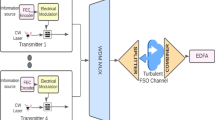Abstract
This study evaluates the bit error rate (BER) performance of a turbo-coded orthogonal frequency division multiplexing (OFDM) communication connection using a terrestrial/wireless free-space optical (FSO) channel, taking atmospheric turbulence into account. The Lognormal probability density function (PDF) statistically represents the turbulence-induced intensity fading in the presence of weak turbulence. Furthermore, for enhancing BER performance, a novel low-complexity turbo code which is a channel coding scheme, and OFDM are recommended. The analysis is carried out using the bandwidth-efficient 16-QAM (quadrature amplitude modulation) modulation technology. According to the simulation results of the proposed model, the 16-QAM modulation scheme, turbo coding parameter, and connection length should be taken into account to ensure system dependability. The simulation demonstrates that over the course of a link length, a reliable communication link (10–9 BER) may be molded for 1 km in weak turbulence fading conditions. For easiness SISO (single input-single output) system has been studied for sustaining targeted BER (10–9) in the existence of weak turbulence fading.
Access this chapter
Tax calculation will be finalised at checkout
Purchases are for personal use only
Similar content being viewed by others

References
Kedar, D., Arnon, S.: Urban optical wireless communication networks: the main challenges and possible solutions. IEEE Commun. Mag. 42(5), S2–S7 (2004)
Henniger H., Wilfert, O.: An Introduction to free-space optical communications. Radio Engineering, 19 (2) (2010)
Duvey, D., Gupta, R.: Review paper on performance analysis of a free space optical system. Int. J. Appl. Innov. Eng. & Manag. IJAIEM 3(6), 135–139 (2014)
Andrews, L. C., Philips R. L., Hopen, C.Y.: Laser Beam Scintillation with Applications. SPIE Optical Engineering Press, Bellingham, WA
Ghassemlooy, Z., Popoola, W., Rajbhandari, S.: Optical Wireless Communications System and Channel Modelling. CRC Press Taylor & Francis Group, pp.378 (2013)
Al-Habash, M. A., Andrews, L. C., Phillips, R. L.: Mathematical model for the irradiance probability density function of a laser beam propagating through turbulent media. Opt. Eng. 1554–1562 (2001)
Wang, Y., Wang, D., Jing, Ma.: On the performance of coherent OFDM systems in free-space optical communication. IEEE Photon. J. 7(4) (2015)
Fang, X., et al.: Channel coding and time-diversity for Optical Wireless Links. Opt. Express 17(2), 872–887 (2009)
Theodoros, A.T., Harilaos, G., Sandalidis, G., Karagiannidis, G.K.: Optical wireless links with spatial diversity over strong atmospheric turbulence channels. IEEE Trans. Wireless Commun. 8(2), 951–957 (2009)
Zhu, X., Kahn, J.M.: Performance bounds for coded free-space optical communications through atmospheric turbulence channels. IEEE Trans. Commun. 51(8), 1233–1239 (2003)
Gupta, N., Prakash, S. J., Kaushal, H., Jain, V. K., Kar, S.: Performance analysis of FSO communication using different coding schemes. AIP Conf. Proc. 387–391 (2011)
Pham, A T., Thang, T C., Guo, S., Cheng, Z.: Performance bounds for Turbo-coded SC-PSK/FSO communications over strong turbulence channels. IEEE ATC-(2011)
Hassan, MD. ZT., Bhuiyan, A., Tanzil, S.M.S., Majumder, S.P.: Turbo-Coded MC-CDMA communication link over strong turbulence fading limited FSO channel with receiver space diversity. ISRN Commun. Netw. 14 (2011)
Gupta, R., Kamal, T.S.: Performance analysis of OFDM based FSO communication system with TCM codes. Int. J. Light. Electron Opt., Optik 248 (2021)
Park, H., John, R.B.: Trellis-coded multiple-pulse-position modulation for wireless infrared communications. IEEE Trans. Commun. 52(4), 643–652 (2004)
Mohan, N., Ghassemlooy, Z., Emma Li, Abadi, M.M., Zvanovec, S., Hudson, R., Hta, Z.: The BER performance of a FSO system with polar codes under weak turbulence. IET Opotelectron. 16, 72–80 (2022)
Sonali, Dixit, A., Jain, V. K.: Analysis of LDPC codes in FSO communication system under fast fading channel conditions. IEEE Commun. Soc. 2, 1663–1673 (2021)
Gupta, R., Kamal, T. S., Singh, P.: Concatenated LDPC-TCM codes for better performance of OFDM-FSO system using Gamma–Gamma fading model. Springer: Wireless Personal Commun. (2018)
Gupta, R., Kamal, T. S., Singh, P.: Performance of OFDM: FSO communication system with hybrid channel codes during weak turbulence. Hindawi: J. Comput. Netw. Commun. (2019)
Vucetic, B., Yuan, J.: Turbo codes: principles and applications. Kluwer Academic Publishers (2000)
Garello, R., Pierleoni, P., Benedetto, S.: Computing the free distance of turbo codes and serially concatenated codes with interleavers: algorithms and applications. IEEE J. Sel. Areas Commun. 19(5), 800–812 (2001)
Author information
Authors and Affiliations
Corresponding author
Editor information
Editors and Affiliations
Rights and permissions
Copyright information
© 2023 The Author(s), under exclusive license to Springer Nature Switzerland AG
About this paper
Cite this paper
Gupta, R. (2023). Performance Analysis of Turbo Codes for Wireless OFDM-based FSO Communication System. In: Abraham, A., Hong, TP., Kotecha, K., Ma, K., Manghirmalani Mishra, P., Gandhi, N. (eds) Hybrid Intelligent Systems. HIS 2022. Lecture Notes in Networks and Systems, vol 647. Springer, Cham. https://doi.org/10.1007/978-3-031-27409-1_75
Download citation
DOI: https://doi.org/10.1007/978-3-031-27409-1_75
Published:
Publisher Name: Springer, Cham
Print ISBN: 978-3-031-27408-4
Online ISBN: 978-3-031-27409-1
eBook Packages: Intelligent Technologies and RoboticsIntelligent Technologies and Robotics (R0)



